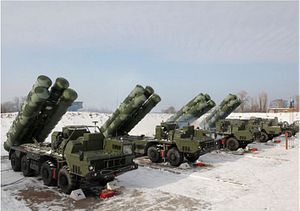Russia’s Federal Service for Military-Technical Cooperation confirmed on June 26 that delivery of five squadrons of Russian-made Almaz-Antei S-400 Triumf air defense systems (NATO reporting name: SA-21 Growler) for service in the Indian Air Force (IAF) will begin in 2020.
“The deliveries of S-400 Triumf missile systems to India are planned to start after 2020, in accordance with the agreement with our partners. Issues with payment have been resolved,” the service was quoted as saying by TASS news agency.
India will likely pay for the Russian-made weapons systems in euros to a Russia-nominated bank to avoid the threat of U.S. sanctions for purchase under U.S. legislation known as the Countering America’s Adversaries Through Sanctions Act (CAATSA), according to The Economic Times.
The legislation mandates sanctions on countries engaging in “significant transactions” — defined as any deals above $15 million — with the Russian state-owned defense industry.
For example, in September 2008, the U.S. imposed sanctions on the People’s Liberation Army’s (PLA) Equipment Development Department (EDD) for China’s induction of S-400 systems and Sukhoi Su-35S (NATO reporting name: Flanker-E) fourth generation, twin-engine, multirole fighter aircraft.
India and Russia signed a $5.5 billion contract for five S-400 squadrons during the 2018 bilateral summit between the two countries.
“The deliveries will commence from October 2020 and will be completed by April 2023,” Indian Minister of State for Defense Subhash Bhamre said in early January in response to a parliamentary question about the $5.5 billion defense contract. “The system will provide a very capable air defense coverage to vulnerable areas/vulnerable points.”
India has persisted in its decision to purchase the Russian-made S-400s despite strong opposition from the United States and has been seeking a sanction waiver by the Trump White House.
As I reported last month, U.S. Principal Deputy Assistant Secretary for South and Central Asia Alice Wells said in an official testimony before the U.S. House of Representatives House Foreign Affairs subcommittee that the induction of S-400 air defense systems can limit India-U.S. military cooperation.
The U.S. has reportedly offered the Indian military the MIM-104F Patriot (PAC-3) surface-to-air missile defense system and the Terminal high Altitude Area Defense (THAAD) system as a replacement for the S-400.
This week I spoke to Mauro Gilli about the risks associated with the potential sale of U.S. high-tech military equipment to countries operating high-tech Russian-made weapons systems such as S-400. Gilli expressed his concern over a potential purchase of U.S. stealth fighters such as the F-35 Lightning II (a more than unlikely proposition in the case of India) by countries also deploying the S-400.
“By modulating the frequencies and angles of operations of multiple S-400 systems, one could find the weak spots of the F-35 and, more important, its unique radar returns,” Gilli notes. “By feeding such data into signal processing software, the chances of detection increases markedly – one country would be able to more accurately ignore false positives and more carefully avoid false negative.”
































